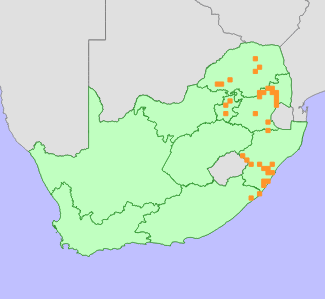|
Scientific Name | Brachycorythis pubescens Harv. |
Higher Classification | Monocotyledons |
Family | ORCHIDACEAE |
National Status |
Status and Criteria | Least Concern |
Assessment Date | 2017/09/22 |
Assessor(s) | L. von Staden |
Justification | Brachycorythis pubescens is a widespread species, but occurs in low densities. It is suspected to be declining due to habitat loss and degradation in parts of its range, but is not yet in danger of extinction. |
Distribution |
Endemism | Not endemic to South Africa |
Provincial distribution | Gauteng, KwaZulu-Natal, Limpopo, Mpumalanga |
Range | This species is widespread across the eastern Highveld, extending southwards to the Pondoland coast. The range extends northwards to tropical Africa. |
Habitat and Ecology |
Major system | Terrestrial |
Major habitats | Legogote Sour Bushveld, KwaZulu-Natal Coastal Belt Grassland, KwaZulu-Natal Coastal Belt Thornveld, KwaZulu-Natal Sandstone Sourveld, Dry Coast Hinterland Grassland, Moist Coast Hinterland Grassland, Paulpietersburg Moist Grassland, Pondoland-Ugu Sandstone Coastal Sourveld, Marikana Thornveld, Steenkampsberg Montane Grassland, Sekhukhune Montane Grassland, Northern Escarpment Quartzite Sourveld, Northern Escarpment Dolomite Grassland, Lydenburg Thornveld, Barberton Montane Grassland, Eastern Highveld Grassland, Southern KwaZulu-Natal Moist Grassland, Carletonville Dolomite Grassland, Drakensberg-Amathole Afromontane Fynbos, Northern Drakensberg Highland Grassland, Southern Drakensberg Highland Grassland, KaNgwane Montane Grassland, Central Sandy Bushveld, Tzaneen Sour Bushveld, Kaalrug Mountain Bushveld, Gold Reef Mountain Bushveld, Mamabolo Mountain Bushveld, Soutpansberg Mountain Bushveld, Makhado Sweet Bushveld, Long Tom Pass Montane Grassland, Western Sandy Bushveld, Waterberg-Magaliesberg Summit Sourveld, Andesite Mountain Bushveld, Midlands Mistbelt Grassland, Mooi River Highland Grassland, Ithala Quartzite Sourveld, Soweto Highveld Grassland, Subtropical Alluvial Vegetation, Waterberg Mountain Bushveld |
Description | It occurs on the edges of wetlands in grassland and in open woodland, 500-2250 m. |
Threats |
| It is threatened in parts of its range due to habitat loss and degradation as a result of urban expansion, agriculture, timber plantations, spreading alien invasive plants and overgrazing. |
Population |
Plants occur scattered in suitable habitat (Johnson and Bytebier 2015). It is suspected to be declining in parts of its range due to habitat loss and degradation.
|
Population trend | Decreasing |
Assessment History |
Taxon assessed |
Status and Criteria |
Citation/Red List version | | Brachycorythis pubescens Harv. | Least Concern | Raimondo et al. (2009) | |
Bibliography |
Johnson, S. and Bytebier, B. 2015. Orchids of South Africa: A field guide. Struik Nature, Cape Town.
La Croix, I. and Cribb, P.J. 1995. Orchidaceae. In: G.V. Pope (ed). Flora Zambesiaca 11 (Part 1):1-320. Flora Zambesiaca Managing Committee, London.
Linder, H.P. 1999. Brachycorythis. In: H.P. Linder and H. Kurzweil (eds.), Orchids of southern Africa (pp. 80-85), A.A. Balkema, Rotterdam.
Raimondo, D., von Staden, L., Foden, W., Victor, J.E., Helme, N.A., Turner, R.C., Kamundi, D.A. and Manyama, P.A. 2009. Red List of South African Plants. Strelitzia 25. South African National Biodiversity Institute, Pretoria.
Summerhayes, V.S. 1955. A revision of the genus Brachycorythis. Kew Bulletin 10:244-245.
|
Citation |
| von Staden, L. 2017. Brachycorythis pubescens Harv. National Assessment: Red List of South African Plants version 2024.1. Accessed on 2025/12/01 |
 Comment on this assessment
Comment on this assessment


